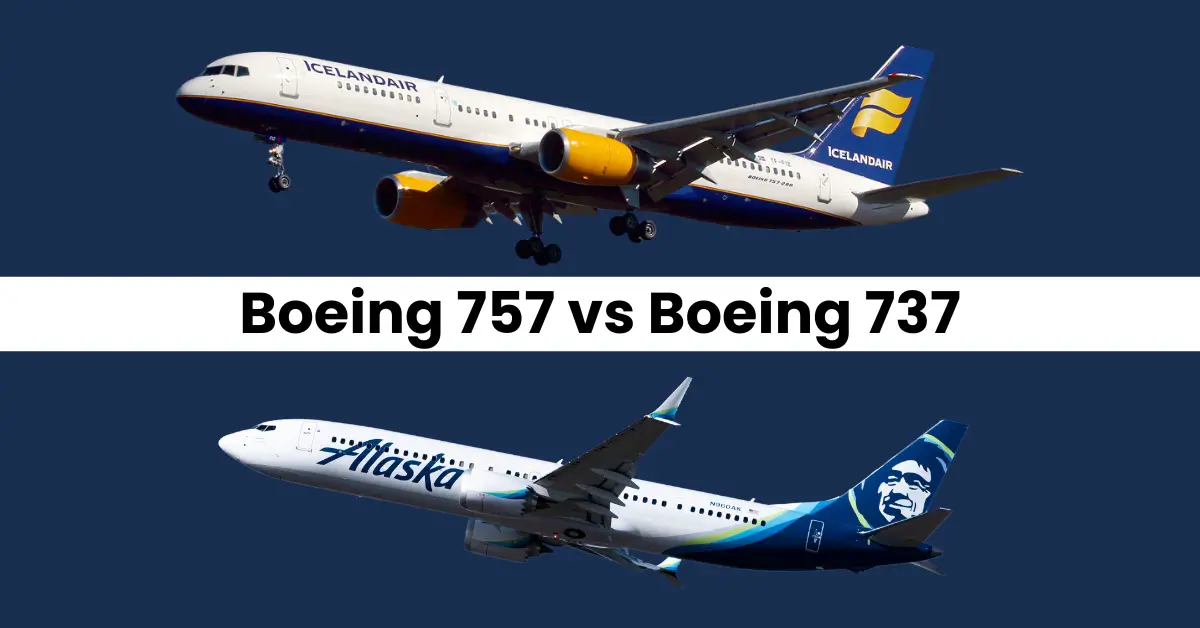Boeing 757 vs 737, the 737 and 757 are both widely recognized as popular Boeing narrow-body twinjets. However, the 737 surpasses the 757 in sales and production longevity. Introduced 16 years prior to the debut of the 757, the 737 has continued its production run for 17 years beyond the cessation of the 757’s manufacture, marking a significant span of dominance in Boeing’s catalog.
Boeing 757 vs 737
When we look at the Boeing 757 vs 737, it’s like comparing two stars in the sky; both shine bright, but they have their unique traits. The 757 is like a powerful giant, known for flying longer distances and carrying more people or cargo because of its bigger size and stronger engines. It’s perfect for airlines that need to cross large areas of water or fly from one continent to another without stopping. On the other hand, the 737 is like a versatile traveler, smaller and not as powerful as the 757, but very good at taking off and landing in shorter spaces, making it ideal for flying between cities or countries that are not too far apart. It’s also cheaper to operate because it uses less fuel. So, in simple terms, airlines pick the 757 for its strength and long reach, and the 737 for its flexibility and cost-effectiveness, depending on what they need the plane to do.
| Specification | Boeing 737-90 | Boeing 757-200 |
|---|---|---|
| Length | 42.10 m (138 ft 1 in) | 47.32 m (155 ft 3 in) |
| Wingspan | 35.80 m (117 ft 5 in) | 38.00 m (124 ft 8 in) |
| Wing Area | 125.00 m² (1,345 ft²) | 185.30 m² (1,995 ft²) |
| Height | 12.50 m (41 ft) | 13.60 m (44 ft 7 in) |
| Engines | 2 | 2 |
| Thrust per Engine | 121 kN (27,300 lbf) | 179 kN (40,200 lbf) |
| Total Thrust | 242 kN (54,600 lbf) | 358 kN (80,400 lbf) |
| Maximum Takeoff Weight (MTOW) | 79,000 kg (174,000 lbs) | 115,680 kg (255,000 lbs) |
| Range | 5,084 km (2,745 nm) | 7,222 km (3,900 nm) |
| Cruise Speed | Mach 0.785 | Mach 0.8 |
| Capacity (Typical) | 177 passengers | 200 passengers |
| Maximum Capacity | 220 passengers | 239 passengers |
This comparison table illustrates the differences and similarities between the Boeing 737-900 and the Boeing 757-200, highlighting aspects such as dimensions, engine performance, capacity, and operational capabilities. The Boeing 757-200 shows advantages in terms of range, capacity, and thrust, reflecting its design for longer routes and larger passenger loads compared to the Boeing 737-900.
Boeing 737

The Boeing 737 is like the workhorse of the sky, known for being one of the most popular airplanes flying around the world. It’s a bit like a reliable car that many airlines love to use for shorter trips. Imagine it as a bus of the air, taking people from one city to another or even across countries without needing a lot of fuel. It’s not too big, but it’s cozy enough and can carry a good number of passengers, making it perfect for all kinds of trips that aren’t too long. Over the years, Boeing has made different versions of the 737, making each new one better, more comfortable for passengers, and friendlier to the environment. It’s a favorite for many airlines because it helps them save money and keeps passengers happy on their journeys.
Boeing 757

The Boeing 757 is like a mighty bird of the skies, known for its impressive ability to fly far and fast. It’s a bit bigger than some other planes, which means it can carry more passengers or go longer distances without stopping for a break. Think of it as a strong athlete who specializes in long races. Airlines love the 757 because it can take off from shorter runways but still travel across big oceans or countries easily. This makes it very handy for flights that might be too long for smaller planes but don’t need a huge airplane. Even though they’re not making new ones anymore, the 757 is still a favorite for many airlines because of its unique mix of strength, size, and agility in the air.
Boeing 757 vs 737 Variants
The Boeing 737 vs 757 both are two iconic aircraft, each with a rich history in the aviation world. The 737 first took to the skies in 1967, marking the beginning of a journey that would see it become one of the most successful aircraft in history. For over 55 years, the 737 has evolved through constant innovation, with the latest versions still rolling off the production line, a testament to its enduring appeal. This is in stark contrast to the 757, which, despite its shorter production span of 22 years, made a significant impact with its capability to handle both short and long-haul flights efficiently.
| Boeing 737 Series | Models Included | First in Service | Last Delivery |
|---|---|---|---|
| Original | 737-100, 737-200 | 1967 | 1988 |
| Classic | 737-300, 737-400, 737-500 | 1984 | 2000 |
| Next Generation | 737-600, 737-700, 737-800, 737-900 | 1997 | In production (737-800/800A only) |
| MAX | 737 MAX 7, 737 MAX 8, 737 MAX 9, 737 MAX 10 | 2017 | In production (737MAX10 from 2023 onwards) |
The 737 family has expanded over four generations, starting with the Original series, including the 737-100 and 737-200, followed by the Classic series with more fuel-efficient variants like the 737-300, 737-400, and 737-500. The Next Generation series introduced even more advanced models such as the 737-600, 737-700, 737-800, and 737-900, further solidifying Boeing’s dominance in the market. The evolution continued with the 737 MAX, incorporating cutting-edge technologies for even greater efficiency.
| Boeing 757 Series | Models Included | First in Service | Last Delivery |
|---|---|---|---|
| 757-200 | Standard passenger model, freighter, and convertible versions | 1983 | 2005 |
| 757-300 | Stretched version of the 757-200, offering more passenger capacity | 1999 | 2004 |
While the 737 has seen numerous variants across its generations, the 757’s legacy is defined by its unique blend of range and payload capabilities, making it irreplaceable for certain operations. Despite the end of its production, the 757 remains a favorite for its specific operational niche. The 737, with its diverse variants and ongoing enhancements, especially in the MAX series, continues to adapt to the changing demands of the aviation industry, ensuring its place in the skies for years to come.
Boeing 757 vs 737 Engines
The Boeing 757 vs 737 have engines that show off the power of innovation in aviation. The 757 uses Rolls-Royce RB211 or Pratt & Whitney PW2000 engines, strong enough to lift a maximum takeoff weight of up to 273,000 pounds. These engines are like the muscles of a heavyweight champion, allowing the 757 to fly long distances with lots of passengers and cargo. In contrast, the 737’s engines are designed with clever engineering to fit under the plane’s wings, despite their large size, because the 737 sits closer to the ground.
The 737 Classic series upgraded to CFM56 engines, which were quieter and 25% more efficient than their predecessors. The Next Generation series improved even further with the CFM56-7, boosting fuel efficiency by 7%. The latest 737 MAX models use LEAP-1B engines, which are even more efficient, expected to be about 10-12% better than the ones before. While the 757 engines focus on power and range, the 737’s engines are all about efficiency and smart design to keep the plane flying efficiently on shorter routes.
Passenger Capacity & Comfort
The Boeing 757 vs 737 both models offer varied seating capacities and configurations, tailored to meet different airline requirements and passenger comfort levels. The 757, known for its larger size, accommodates a wider range of passenger loads, from 180 to 240 across its variants and class configurations. This variability reflects how airlines prioritize cabin space, with options for one, two, or three classes, affecting the total number of seats and the comfort offered, especially in premium classes.
| Aircraft | Configuration | 1-Class Max Seats | 2-Class Typical Seats | 3-Class Max Seats | Maximum Seats |
|---|---|---|---|---|---|
| 757-200 | 1-Class | 235 – 238 | – | – | – |
| 2-Class | – | 183 | – | – | |
| 3-Class | – | – | 142 – 199 | – | |
| 757-300 | 2-Class | – | 225 – 262 | – | – |
| 3-Class | – | – | 234 | – | |
| 737MAX7 | 2-Class | – | 138 – 153 | – | 172 |
| 737MAX8 | 2-Class | – | 162 – 178 | – | 210 |
| 737MAX9 | 2-Class | – | 178 – 193 | – | 220 |
| 737MAX10 | 2-Class | – | 188 – 204 | – | 230 |
In contrast, the 737 MAX series, despite having a similar fuselage width to the 757, caters more to short to medium-haul flights, with seating arrangements designed to optimize capacity while maintaining passenger comfort. The seating capacity across the 737 MAX variants ranges significantly, from a more intimate 138 in a two-class configuration on the MAX 7 to a robust 230 maximum seats on the MAX 10, showcasing its flexibility to meet airline and route demands.
Boeing 757 vs 737 Prices
| Aircraft Model | List Price (approx., in USD) | Remarks |
|---|---|---|
| Boeing 757-200 | $35-55 million (used) | Price range varies significantly based on the aircraft’s age, condition, and configuration. |
| Boeing 757-300 | $40-60 million (used) | Similar to the 757-200, the price is influenced by various factors including age and market demand. |
| Boeing 737 MAX 7 | $99.7 million | Latest list price; actual sales price may be lower due to negotiations. |
| Boeing 737 MAX 8 | $121.6 million | Latest list price; discounts often applied. |
| Boeing 737 MAX 9 | $128.9 million | Reflects the list price; subject to negotiations. |
| Boeing 737 MAX 10 | $134.9 million | The largest MAX variant’s list price; negotiations can affect final price. |
This table highlights the stark difference in pricing between the newer 737 MAX series and the older, out-of-production 757 models. While the 737 MAX variants come with modern efficiencies, technologies, and higher list prices, the 757s offer a more affordable option for carriers not requiring the latest aircraft or those seeking specific performance capabilities no longer available in newer narrow-body models.
Conclusion
In the aviation industry, comparing the Boeing 757 vs 737 highlights their distinct design, capabilities, and technological advancements. The 737 is renowned for its popularity and versatility, ideal for short to medium flights, while the 757 is prized for its superior range, payload, and performance, perfect for specific routes. The choice between them depends on the airline’s specific needs and operations. Both models have significantly impacted the aviation world, providing reliable service to airlines and passengers alike. Looking ahead, the legacy of the 757 and 737 will continue to shape the future of air travel through ongoing innovations in aviation technology.
FaQs
What are the main differences between the Boeing 757 and 737?
Can the Boeing 737 carry as many passengers as the 757?
Are both aircraft still in production?
Why do some airlines still prefer the Boeing 757?
Is the Boeing 737 safer than the 757?
What will replace the Boeing 757 and 737?



